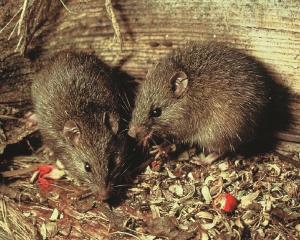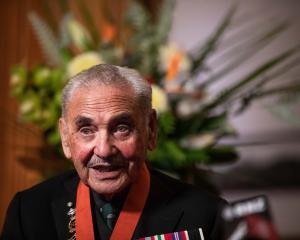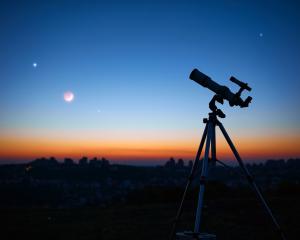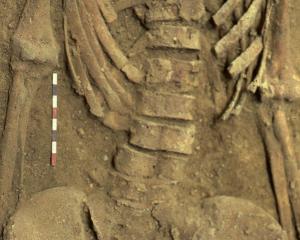Dr Bastian Egeter is about to return to his Irish homeland, with a new PhD from the University of Otago. His contribution to Orokonui Ecosanctuary during his time in Dunedin has been wide-ranging, and his departure is regretted by all who have worked with him. Here he reflects on the part Orokonui has played in his own development.
Surrounding the coffee table, pondering their next move, are ''big Al'', a semi-retired nematode zoologist, a frog-loving Irishman, a Canadian parasitologist, an ex-nurse, a human resources administrator, the mother of an enthusiastic child and a dog called Jess.
Perhaps this could be the start of what would have to be a very elaborate joke, but in fact these are just a few members of a team of dedicated volunteers about to commence their day looking for lizards at Orokonui Ecosanctuary.
Since January, the team has been checking 100 lizard monitoring stations fortnightly within the protective fence surrounding the sanctuary.
This summer formed the first season of what will become a long-term lizard monitoring programme intended to run for at least a decade, but hopefully much longer, to find out how lizards are faring in the absence of introduced mammals.
Although in its infancy, there are already encouraging results: 14 southern grass skinks and one Otago large gecko were observed using the ''lizard hotels'', with many of the skinks being juveniles, indicating they are breeding successfully.
I have been involved in this lizard project since the outset and have thoroughly enjoyed being part of it.
But this is also the story of someone profoundly affected by Orokonui and I would like to bring you back to the beginning of my involvement with the sanctuary.
I arrived in New Zealand in February 2008, just eight months after the fence was officially completed.
It wasn't long before my first visit and I became enthralled with the techniques and potential of the ambitious project. So, in early 2009, under the guidance of Prof
Phil Bishop, I carried out a study assessing the habitat at Orokonui for the potential translocation of New Zealand native frogs, which have been absent from the South Island mainland for hundreds of years.
This research has since been carried on by master's student Luke Easton (Wild Ways, March 9, 2015).
My interest in frogs developed from there and I embarked on a master's degree project investigating the impacts of mammals on frogs, but it seemed my topic was larger than I anticipated and the master's quickly grew into a PhD.
As part of the project I fed dead frogs to wild rats in the lab, to see if they liked the taste (zoologists are sometimes an odd bunch), and soon found myself back at Orokonui, as where better to remove some rats, than from the area outside the fence.
In April 2011 our frog research group organised a ''Save the Frogs Day'' event at Orokonui, part of a worldwide movement to inform people of the global amphibian extinction crisis that is taking place.
It was then that I first met Tahu Mackenzie, Orokonui's popular learning experiences outside the classroom (LEOTC) education officer.
We had a great day showing children around, searching for frogs and even inventing frog dances (much to my initial embarrassment).
From then until now I have myself been an educator at Orokonui.
Sharing my enthusiasm for science and ecology has not only been extremely enjoyable and rewarding, but has given me an entirely new outlook on conservation and our place within it.
I have seen first-hand the excitement, joy and curiosity of children and adults alike, as they sight a robin by a stream gully, discover a water boatman in the eel pond, find a skink basking on a rock and even formulate complicated concepts of habitat restoration.
But perhaps the most important message learned is the realisation of our integral part in this recovery process.
We often view humans as the destructive force driving animal and plant extinctions, and there is some truth to that, but there is also another side.
The vast majority of people with whom I have worked during my time at Orokonui, by now numbering in the thousands, are concerned, enthusiastic, hopeful and deeply caring people who are committed to playing a part in the restoration of New Zealand's natural heritage.
Without the contribution of such students, visitors, volunteers, staff and scientists things would be very much worse.
Orokonui is indeed ''not just for the birds'' as Dr Kelvin Lloyd, a trustee of the Orokonui project, pointed out, referring to its equal importance for native flora (Wild Ways, December 3, 2011).
To go even further, Orokonui is not just for the flora and fauna, but for the people, too.
It builds community and brings people together from all walks of life, it fosters learning and a sense of responsibility for our environment, and it increases awareness of both the problems we face and the solutions we can achieve by working together.
I feel incredibly privileged to have been a part of the Orokonui project, and although I must leave New Zealand soon, it will always remain with me and I look forward to returning in the future and revisiting a place that has moulded much of my adult life.
For more on Bastian's research visit www.nzfrogs.org.












